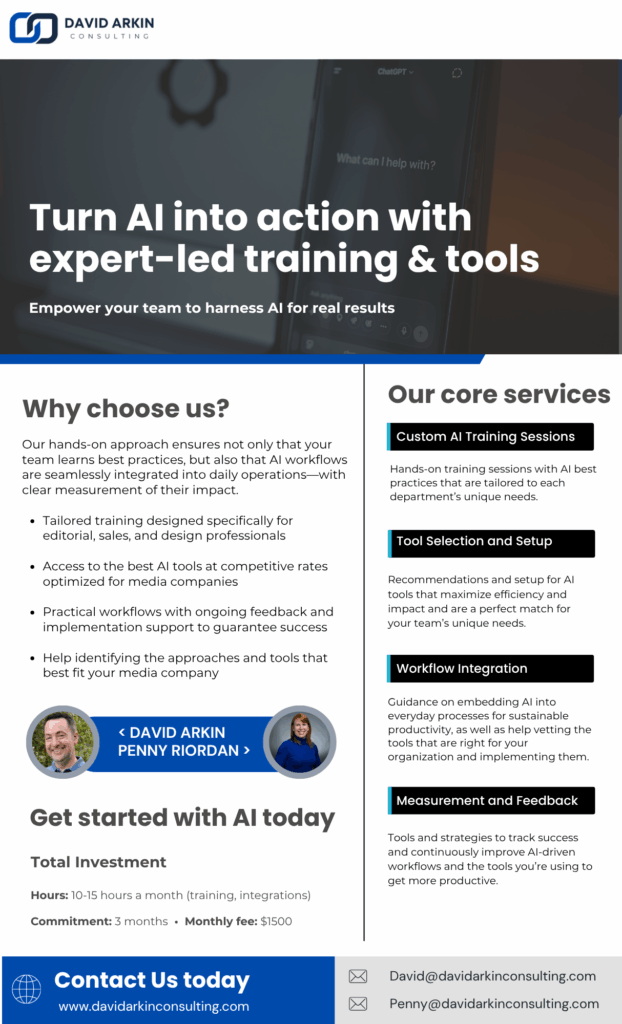
As more media companies navigate how their organizations might use AI responsibly but effectively, there are some common questions I am hearing.
So in today’s newsletter, I’m going to walk you through some of them as I anticipate they may be questions you also have.
What happens when you share content and data in a tool like ChatGPT?
Basically, anything you type in can be used to improve the model which means that if you ask AI to do something simple like provide you a headline suggestion, then your content is now being used for others to tap into.
You can think a little wider about that and see why this is a problem. If your team is posting content or advertising lists or unfinished work in a free and open platform, then you’re potentially providing an advantage to your competition. You very well could have content out there in the wild that you don’t want anyone else gaining access to.
FREE GUIDE
Download our 25-page branded content handbookThis detailed guide provides you everything you need to know about growing your branded content business with best practices in pricing, packaging and content creation.
"*" indicates required fields
How do I actually protect my data?
Your team really needs to be using a Plus, Team or Enterprise account . However, there are key differences between them.
With ChatGPT Plus, you can prevent your content from being used to train OpenAI’s models, but you have to manually turn on data-control settings in your account to do so.
Enterprise accounts provide the highest level of protection as data is not used for training, analytics or model improvement, and administrators can control permissions.
If your company needs even stricter safeguards there are more advanced enterprise options that can provide full isolation from public systems.
Even with these protections in place, it’s still wise to be cautious about uploading sensitive materials like advertiser contracts, unpublished drafts or financial data. The most important step is having a clear internal policy that defines what tools your team can use and what data should never be shared.
Does Google like AI content?
Yes but it really depends on how you use it. What news organizations should not do is ask AI to just write a story as that is unoriginal and kind of lazy.
Google isn’t going to punish publishers that use AI as long as you use it to assist with drafts, ideas, or formatting and this is the most important part, that an actual human reviews and does original work on the content.
What are the best editorial use cases?
There are so many but here are the top ones:
- Getting story ideas and follow ups
- Summarizing long documents
- Optimizing everything: headlines, stories, social media, newsletters
- Meeting transcript to summarize top takeaways
One of the best uses is around editing, specifically creating a GPT that flags things that will make your story stronger: better sentence structure, grammar issues, fact checking and style checks.
We have created several of these for clients recently, as a tool to help reporters and digital producers to get feedback before sending to an editor for a review. The results have been great.
Can proposals be created through AI?
Yes, absolutely. The creation of proposals can be an overwhelming process, but opposed to starting from scratch each time, you can create a GPT that allows you to build something that is repeatable when it comes to your proposals.
You simply need to tell the GPT what you want in the proposal: Pricing tiers, terms, the value you offer and then share a template of your proposal.
Reps then just have to enter the advertiser’s name, campaign goals, deliverables and cost, and you have a beautiful proposal.
What’s important when making a GPT?
You have to make sure that the instructions are very specific, really overly specific. You want to clearly tell it who it’s writing for, what style to use, and what it should and shouldn’t do.
Here’s a nice prompt for an editing GPT:
”Review all copy for grammar, clarity, accuracy, and readability. Flag passive voice, repetition, or confusing phrasing. Suggest stronger leads, smoother transitions, and SEO-friendly headlines. Do not change quotes or facts, but flag issues that need human review.”
We’d love to help you implement AI
We have an AI program that provides the training, workshops and implementation that help media companies find their way through AI. Download our flyer here and contact me today at david@davidarkinconsulting.com

We'd love to help your organization! Fill out the form below to get started.
Recent Posts

Answers to your pressing AI questions

Here are practical ideas for your 2026 special sections, themes and guides

Here’s why these editorial GPTs work

Our 3-tier fractional officer program provides best practices, training and implementation

The most pressing questions advertisers are asking us about branded content
Case Studies

How analytics can make your content better and your sales case studies really effective

How this unique coaching program taught a reporter the digital skills she needs for the future

How branded content sales exploded for this newspaper in New York

How a TV station in South Dakota significantly grew its traffic through Stacker’s news wire

